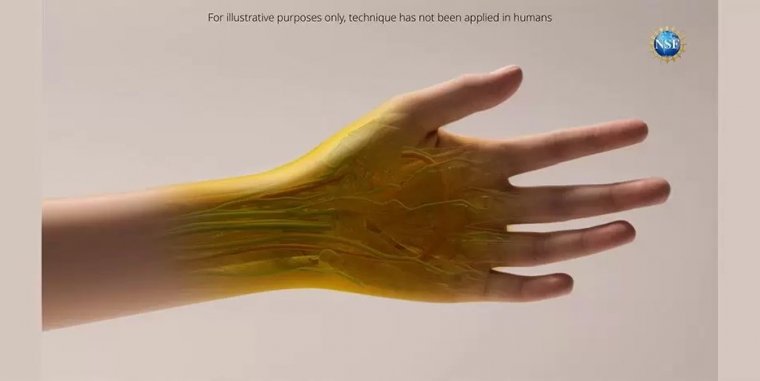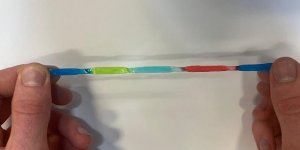| Technology |
Groundbreaking technique makes skin transparent
Researchers have developed a new way to see organs within a body by rendering overlying tissues transparent to visible light.

Illustration of a human hand as it might appear if the new tissue transparency effect proves effective in humans. Currently, the effect has only been tested with animals in a laboratory setting. Note that dyes may be harmful. Always exercise caution with dyes and do not consume directly, apply to people or animals, or otherwise misuse. Photo: Keyi "Onyx" Li/U.S. National Science Foundation
The counterintuitive process—a topical application of food-safe dye—was reversible in tests with animal subjects, and may ultimately apply to a wide range of medical diagnostics, from locating injuries to monitoring digestive disorders to identifying cancers.
″Looking forward, this technology could make veins more visible for the drawing of blood, make laser-based tattoo removal more straightforward, or assist in the early detection and treatment of cancers,″ said Stanford University assistant professor of materials science and engineering Guosong Hong, a U.S. National Science Foundation CAREER grantee who helped lead this work.
″For example, certain therapies use lasers to eliminate cancerous and precancerous cells, but are limited to areas near the skin’s surface. This technique may be able to improve that light penetration.″
To master the new technique, the researchers developed a way to predict how light interacts with dyed biological tissues.
Those predictions required a deep understanding of light scattering, as well as the process of refraction, where light changes speed and bends as it travels from one material into another.
Scattering is the reason we cannot see through our body: Fats, fluids within cells, proteins, and other materials each have a different refractive index, a property that dictates how significantly an incoming light wave will bend.
In most tissues, those materials are closely compacted together, so the varied refractive indices cause light to scatter as it passes through. It is the scattering effect that our eyes interpret as opaque, colored, biological materials.
The researchers realized if they wanted to make biological material transparent, they had to find a way to match the different refractive indices so light could travel through unimpeded.
Building upon fundamental insights from the field of optics, the researchers realized dyes that are the most effective at absorbing light can also be highly effective at directing light uniformly through a wide range of refractive indices.
One dye the researchers predicted would be particularly effective was tartrazine, the food dye more commonly known as FD & C Yellow 5. It turns out, they were correct: When dissolved into water and absorbed into tissues, tartrazine molecules are perfectly structured to match refractive indices and prevent light from scattering, resulting in transparency.
The researchers first tested their predictions with thin slices of chicken breast. As tartrazine concentrations increased, the refractive index of the fluid within the muscle cells rose until it matched the refractive index of the muscle proteins – the slice became transparent.
Then, the researchers gently rubbed a temporary tartrazine solution on mice. First, they applied the solution to the scalp, rendering the skin transparent to reveal blood vessels crisscrossing the brain.
Next, they applied the solution to the abdomen, which faded within minutes to show contractions of the intestine and movements caused by heartbeats and breathing.
The technique resolved features at the scale of microns, and even enhanced microscope observations. When the dye was rinsed off, the tissues quickly returned to normal opacity. The tartrazine did not appear to have long-term effects, and any excess was excreted in waste within 48 hours.
The researchers suspect that injecting the dye should lead to even deeper views within organisms, with implications for both biology and medicine. (U.S. National Science Foundation)
YOU MAY ALSO LIKE





